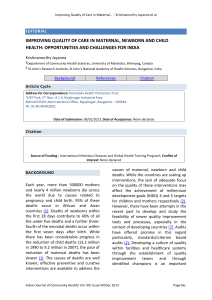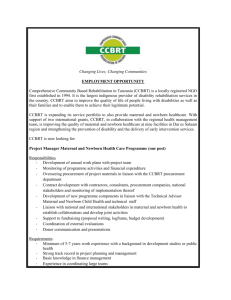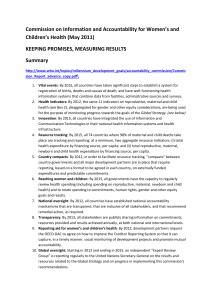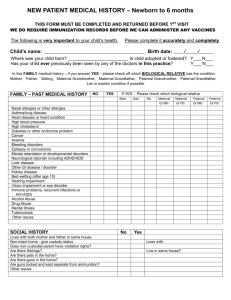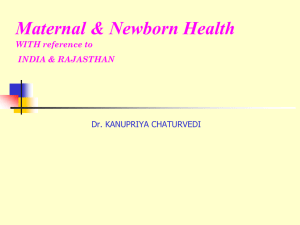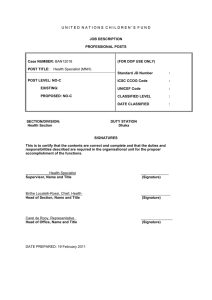Improving Quality of Care in Maternal*
advertisement
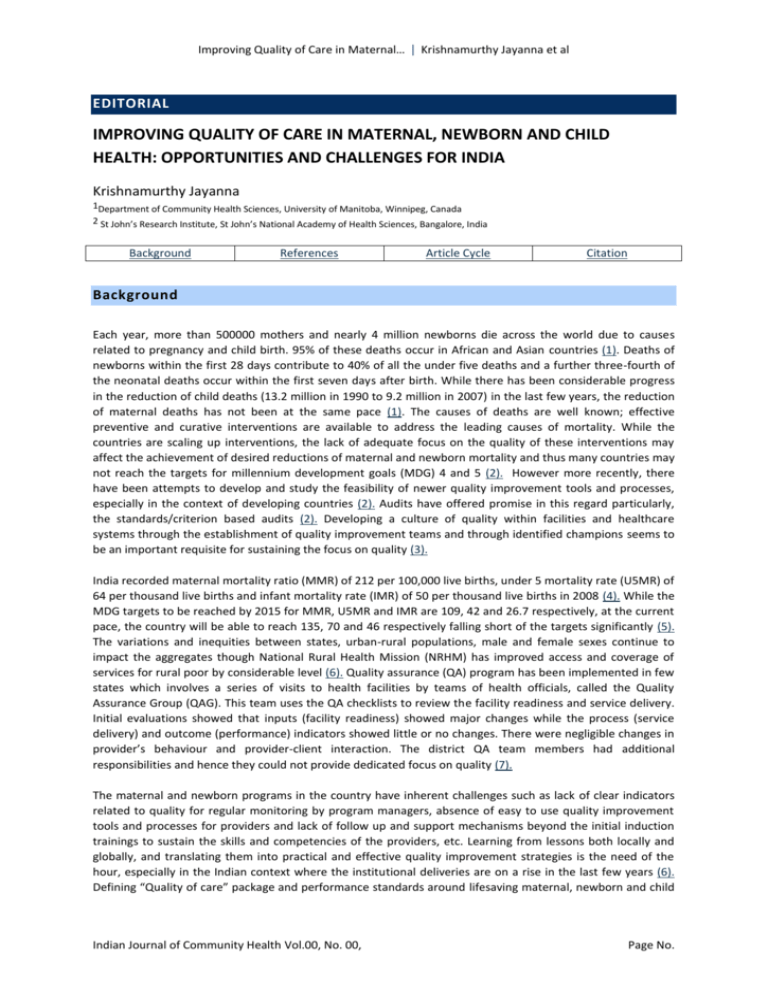
Improving Quality of Care in Maternal… | Krishnamurthy Jayanna et al EDITORIAL IMPROVING QUALITY OF CARE IN MATERNAL, NEWBORN AND CHILD HEALTH: OPPORTUNITIES AND CHALLENGES FOR INDIA Krishnamurthy Jayanna 1Department of Community Health Sciences, University of Manitoba, Winnipeg, Canada 2 St John’s Research Institute, St John’s National Academy of Health Sciences, Bangalore, India Background References Article Cycle Citation Background Each year, more than 500000 mothers and nearly 4 million newborns die across the world due to causes related to pregnancy and child birth. 95% of these deaths occur in African and Asian countries (1). Deaths of newborns within the first 28 days contribute to 40% of all the under five deaths and a further three-fourth of the neonatal deaths occur within the first seven days after birth. While there has been considerable progress in the reduction of child deaths (13.2 million in 1990 to 9.2 million in 2007) in the last few years, the reduction of maternal deaths has not been at the same pace (1). The causes of deaths are well known; effective preventive and curative interventions are available to address the leading causes of mortality. While the countries are scaling up interventions, the lack of adequate focus on the quality of these interventions may affect the achievement of desired reductions of maternal and newborn mortality and thus many countries may not reach the targets for millennium development goals (MDG) 4 and 5 (2). However more recently, there have been attempts to develop and study the feasibility of newer quality improvement tools and processes, especially in the context of developing countries (2). Audits have offered promise in this regard particularly, the standards/criterion based audits (2). Developing a culture of quality within facilities and healthcare systems through the establishment of quality improvement teams and through identified champions seems to be an important requisite for sustaining the focus on quality (3). India recorded maternal mortality ratio (MMR) of 212 per 100,000 live births, under 5 mortality rate (U5MR) of 64 per thousand live births and infant mortality rate (IMR) of 50 per thousand live births in 2008 (4). While the MDG targets to be reached by 2015 for MMR, U5MR and IMR are 109, 42 and 26.7 respectively, at the current pace, the country will be able to reach 135, 70 and 46 respectively falling short of the targets significantly (5). The variations and inequities between states, urban-rural populations, male and female sexes continue to impact the aggregates though National Rural Health Mission (NRHM) has improved access and coverage of services for rural poor by considerable level (6). Quality assurance (QA) program has been implemented in few states which involves a series of visits to health facilities by teams of health officials, called the Quality Assurance Group (QAG). This team uses the QA checklists to review the facility readiness and service delivery. Initial evaluations showed that inputs (facility readiness) showed major changes while the process (service delivery) and outcome (performance) indicators showed little or no changes. There were negligible changes in provider’s behaviour and provider-client interaction. The district QA team members had additional responsibilities and hence they could not provide dedicated focus on quality (7). The maternal and newborn programs in the country have inherent challenges such as lack of clear indicators related to quality for regular monitoring by program managers, absence of easy to use quality improvement tools and processes for providers and lack of follow up and support mechanisms beyond the initial induction trainings to sustain the skills and competencies of the providers, etc. Learning from lessons both locally and globally, and translating them into practical and effective quality improvement strategies is the need of the hour, especially in the Indian context where the institutional deliveries are on a rise in the last few years (6). Defining “Quality of care” package and performance standards around lifesaving maternal, newborn and child Indian Journal of Community Health Vol.00, No. 00, Page No. Improving Quality of Care in Maternal… | Krishnamurthy Jayanna et al health (MNCH) services and systematizing the monitoring of these indicators at all levels has to be initiated (2), (3). Job-aid to assist providers in adhering to protocols and simple tools to audit the quality of care should be provided. The emerging performance gaps have to be addressed through a system of continuous follow up and feedback by a dedicated cadre of mentors who can stay focused and committed to improving the quality of care. The various parts of health system such as human resources, monitoring and information systems, supply chain, capacity building systems have to converge in order to facilitate a coordinated action toward improving the quality of MNCH care at district and sub district level. With just a few years left to reach MDG targets, it is time to rededicate our efforts and investments to ensure that the proven and effective interventions that are offered to the women, newborn and children are of highest quality in order to achieve better maternal, newborn and child health outcomes. References 1. United Nations Children’s Fund (UNICEF). The State of World’s Children 2009: Maternal and Newborn Health. New York. UNICEF. December 2008. Pg 2-7. http://www.unicef.org/protection/SOWC09-FullReport-EN.pdf. Accessed July 28th, 2013 2. Van den Broek, N and Graham W. Quality of care for maternal and newborn health: the neglected agenda. BJOG. 2009 Oct; 116 Suppl 1: 18–21. doi: 10.1111/j.1471-0528.2009.02333.x. Cited in Pubmed; PMID: 19740165. 3. Raven J, Hofman J, Adegoke A, van den Broek N. Methodology and tools for quality improvement in maternal and newborn health care. Int J Gynaecol Obstet. 2011 Jul; 114(1):4-9. doi: 10.1016/j.ijgo.2011.02.007. Cited in Pubmed; PMID: 21621681. 4. Office of Registrar General, India. Maternal and Child Mortality and Total Fertility rates. Sample Registration Systems (SRS). 7th July 2011. http://censusindia.gov.in/vital_statistics/SRS_Bulletins/MMR_release_070711.pdf Accessed January 2nd, 2013. 5. Central Statistical Organization, Ministry of Statistics and Programme Implementation. Millennium Development Goals. India Country report 2009: Mid-Term Statistical Appraisal. New Delhi. Government of India. 2009. Pg 16-17. http://mospi.nic.in/rept%20_%20pubn/ssd04_2009_final.pdf. Accessed July 28th 2013. 6. Ministry of Health and Family Welfare and United Nations Children’s Fund (UNICEF). National Fact Sheet. Coverage Evaluation Survey. New Delhi. Government of India. 2009. http://www.unicef.org/india/National_Fact_Sheet_CES_2009.pdf. Accessed July 28th, 2013. 7. Krishna MC. Quality Assurance for RCH Services: The Karnataka Experience. KHSRC e bulletin. 2011. http://kshsrc.org/qualityassurance-for-rch-services-the-karnataka-experience/. Accessed July 28th, 2013. Article Cycle Conflict of Interest: None Source of Funding : Nil Date of Submission : 00/00/00 Date of Revision : 00/00/00 Date of Acceptance : 00/00/00 Citation Indian Journal of Community Health Vol.00, No. 00, Page No.
